
table of contents
- Indoor ferns from A to G
- from H to J
- from K to N
- from O to R
- from S to Z
- Care instructions for indoor ferns
- frequently asked Questions
When looking for a house fern, you are spoiled for choice. This article introduces 20 species that can be attractively staged with their intense green.
In a nutshell
- Indoor ferns reach lower heights
- prefer bright locations
- bathrooms with a window are well suited
- need sufficiently high humidity
Indoor ferns from A to G
Upright sword fern (Nephrolepis exaltata)
- upright growth, overhanging
- 40 to 150 cm high
- light green, sickle-shaped fronds
- up to 100 cm long
- forms a slender rhizome
- Spores warty or wrinkled
- is considered an air purifier
- ideal for hanging baskets or flower columns

Tip: The sword fern is one of the few indoor ferns that you can put in the sun. The plants only need to be protected from the midday sun.
Double-hulled fern (Didymochlaena truncatula)
- Height from 30 to 200 cm
- as a house fern usually 30 to 60 cm
- upright, slightly overhanging growth
- leathery fronds, 30 to 50 cm long
- shimmering deep green color
- suitable for hydroponics
- alternatively suitable for balconies and terraces in summer
- is considered an air purifier
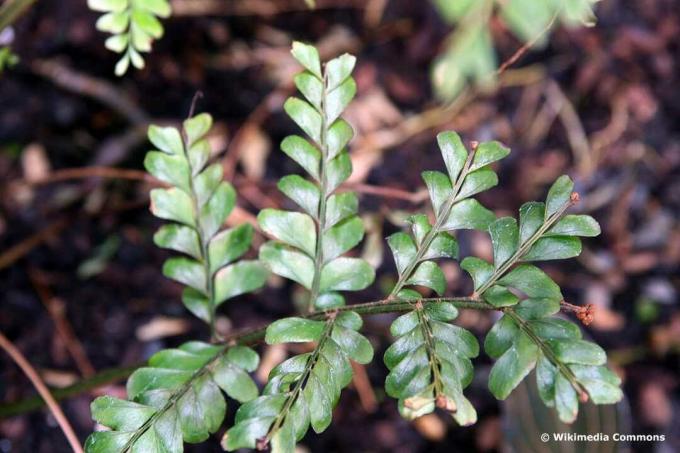
Maidenhair fern (Adiantum raddianum)
- dense growth, overhanging, bushy
- upright stems, dark brown, thin (reminiscent of women's hair)
- 50 to 100 cm high
- Fronds up to 50 cm long
- light green leaflets, triangular, rounded
- also suitable for garden planting
- ideal for rock gardens
- is used in naturopathy despite its low toxicity
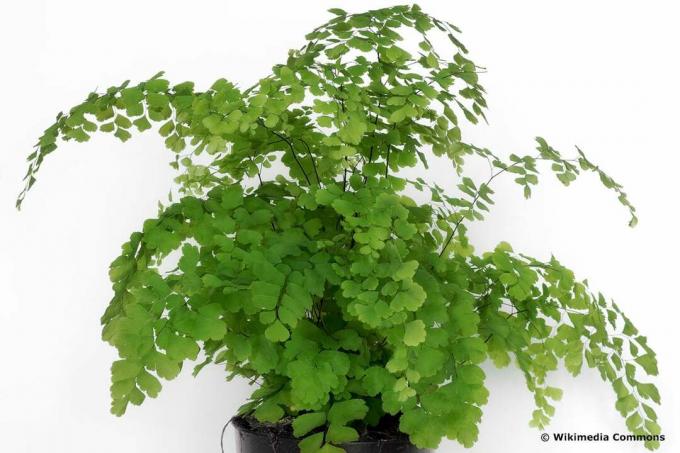
Antler fern (Platycerium bifurcatum)
- spreading growth, slightly overhanging
- Epiphytes (not as a houseplant)
- decorative leaves
- are reminiscent of deer or elk antlers
- Leaves branch out more in adult specimens
- gray-green color
- 30 to 90 cm long
- also forms niche leaves on the floor
- serve to absorb water and nutrients
- die by themselves (do not remove)
- ideal for hanging baskets
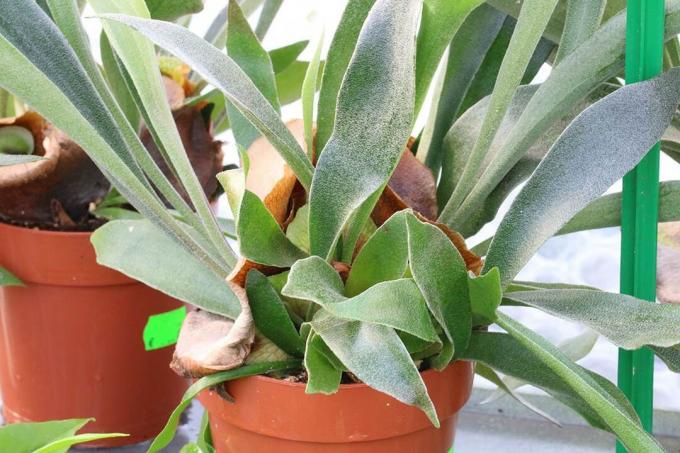
Golden spotted fern (Phlebodium aureum)
- 50 to 100 cm high
- upright growth, spreading
- Stem clearly visible
- blue-green fronds
- 30 to 50 cm long
- forms yellow-brown rhizomes, hairy
- Spore bearing in golden yellow color
- on the underside of the fronds
- Gloves recommended when in contact with the plant
- releases hydrogen cyanide when damaged
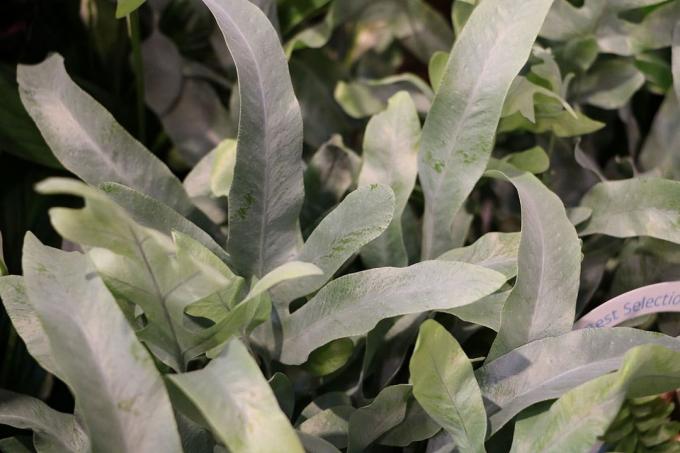
from H to J
Harespaw Fern (Davallia bullata)
- 20 to 30 cm high
- bushy growth, overhanging
- Epiphytes (not as a houseplant)
- 30 to 50 cm long fronds
- pale green in color, distinctly pinnate
- spreading rhizomes
- protrude beyond the pot
- Rhizomes brown and hairy (reminiscent of rabbit paws)
- ideal for hanging baskets
- alternatively tall clay pots or shallow buckets
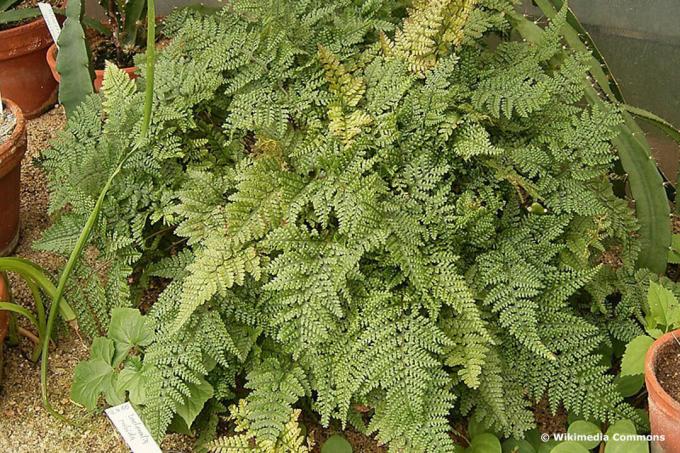
Heart fern (Hemionitis arifolia)
- Growth height of 20 to 30 cm
- compact growth
- thin stems, difficult to see
- forms individual leaves in different shapes
- heart-shaped, 5 to 6 cm in size, sterile
- arrow-shaped, up to 4 cm tall, fertile and spore-forming
- deep green
- ideal companion for tropical plants
- suitable for terrariums
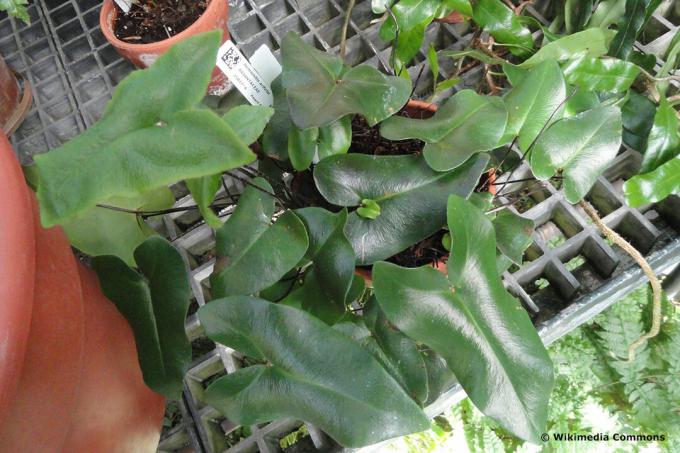
Tip: If you want to suppress the sporulation of the heart fern, carefully remove the arrow-shaped leaves. This will remove the fertile leaves.
from K to N
Kangaroo fern (microsorum diversifolium)
- loose growth, upright
- Height from 30 to 50 cm
- intense dark green foliage, 20 to 50 cm long
- shiny, elongated, tapering to a point
- extremely robust room fern
- high heat tolerance
- suitable for terrariums
- excellent hanging plant
- easily confused with Microsorum punctatum
- less often confused with gold pot farm

Small tufted fern (Salvinia minima)
- Growth height of 10 to 15 cm
- Floating plant
- excellent entry-level plant for aquariums
- floating freely in the water
- equipped with green floating leaves
- 1.5 cm tall, round
- forms dense carpets

Note: So that the small tufted fern does not die, it should only be cultivated in an aquarium with other aquatic plants and animal inhabitants. It does not survive long in bowls, buckets or other vessels that are only filled with water.
Cliff Fern (Pellaea rotundifolia)
- Growth height of 20 to 30 cm
- dense growth, creeping
- 30 to 50 cm long fronds, overhanging
- dark green, leathery, shiny
- robust house fern
- excellent hanging plant

Note: Compared to the other house fern species, the cliff fern or pelle fern tolerates calcareous water and persistent drought. For this reason, it is much easier to care for and ideal for beginners.
Cretan border fern (Pteris cretica)
- 30 to 90 cm high
- dense growth, upright, overhanging
- Leaves 50 to 60 cm long, lanceolate, leathery
- up to 20 cm long filigree stems
- Rhizomes form leaves up to 100 cm long
- light green color, dark margin, slightly shiny
- well suited as a specimen plant

Moss fern (Selaginella apoda)
- flat growth, forms dense cushions
- well branched
- reaches heights of growth of 10 to 15 cm
- are reminiscent of moss pillows
- yellow to deep green leaves, tips bear sporophylls
- suitable for winter gardens
- ideal in small pots or hanging baskets

from O to R
Oil fern (Microsorum thailandicum)
- slowly growing house fern
- lying to upright growth
- up to 30 cm high and wide
- intense blue foliage with a metallic sheen
- Underside colored blue-green
- Leaves up to 30 cm long, leathery, robust
- can be integrated as an accent or as a solitaire
- Can be combined appropriately due to the color
- tolerates full shade
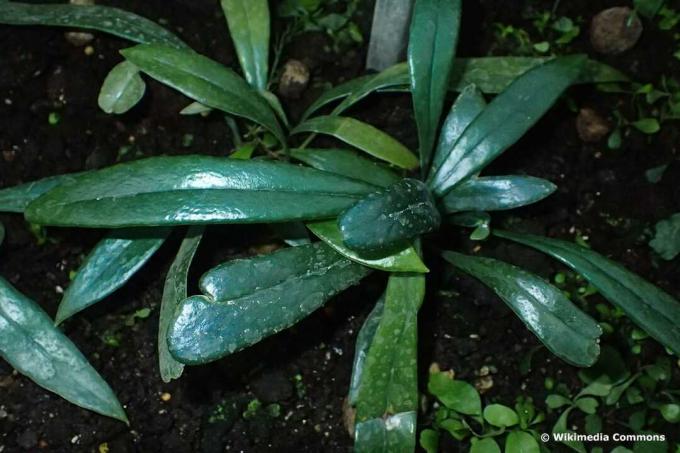
Rib fern (Blechnum gibbum)
- up to 100 cm high indoor fern
- upright growth, forms clumps
- 2 different leaf shapes
- spore-bearing fronds, up to 40 cm long, in the center of the fern
- sporeless fronds, up to 50 cm long, outdoors
- Fronds light green, leathery, narrow
- In older specimens, the rhizome transforms into a stem
- evergreen fern
- also suitable for garden planting
- tolerates temperatures up to 3 ° C
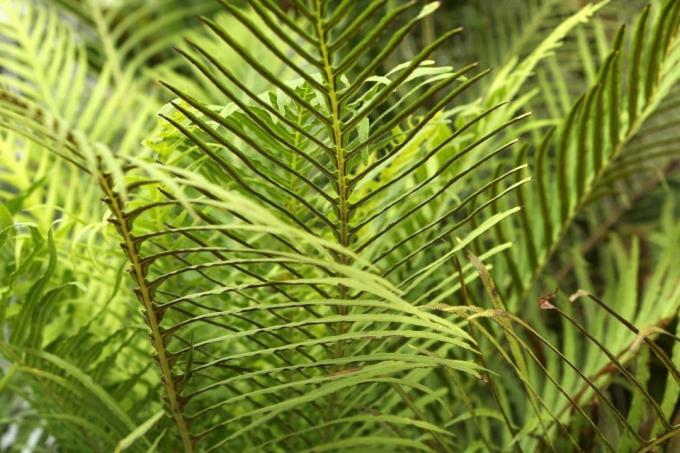
from S to Z
Shield fern (Polystichum luctuosum)
- Growth height of 20 to 40 cm
- forms clumps, dense growth
- Fronds up to 40 cm long
- dark green leaves, black blades, pinnate
- ideal for Asian design concepts
- also suitable for garden planting
- excellent in rock gardens
- tolerates short periods of frost

Snake leaf fern (Aglaomorpha coronans "Snake Leaf")
- up to 50 cm high
- upright growth, loose, overhanging
- Leaf fronds up to 100 cm long
- dark green leaves, oblong shaped
- Foliage is reminiscent of snakeskin
- decorative accent
- is suitable as a solitary plant or in plant pillars

Black forest fern (Dryopteris cycadina)
- grows 60 to 80 cm high
- narrow growth, upright, loose
- up to 60 cm long leaf fronds
- dull green foliage, pinnate
- black haired rachis
- evergreen fern
- also suitable for garden planting
- takes up a lot of space
- Conservatories are ideal as a location

Holly fern (Cyrtomium falcatum)
- 50 to 70 cm high
- broad growth, loose
- up to 50 cm long fronds
- Stems thin and long
- light green foliage, pinnate
- can also be serrated or notched
- decorative as a solitaire or in combination with other indoor ferns
- also suitable for garden planting

Bird nest fern (Asplenium nidus)
- 90 to 100 cm high growth
- upright, spreading room fern
- overhanging leaf fronds, lanceolate shape
- deep green, weakly to strongly wavy
- Leaf fronds can take up a lot of space
- Spore bearing clearly visible on the underside
- is considered an air purifier
- decorative in extensive pot gardens

Pygmy clover (Marsilea crenata)
- Growth height up to 10 cm
- ground covering, long stems
- Foliage resembles clover
- young leaves brown, then intensely green
- decorative in pot gardens, plant pillars or as a solitaire (e.g. on the desk)
- also suitable as an underwater and aquarium fern
- forms dense carpets in the water, a maximum of 3 cm high
- The shape of the leaves is then rounded
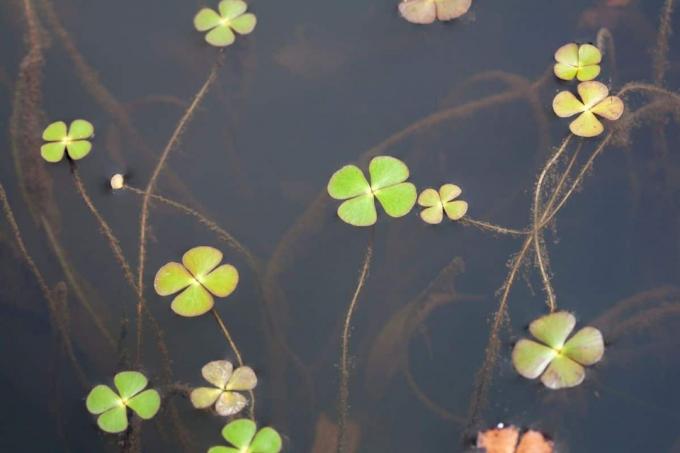
Care instructions for indoor ferns
A big advantage of indoor ferns is that they are easy to care for. The most important thing when cultivating the potted plants is the location:
- Light requirement: bright
- no direct sun or shade
- permanently warm (min. 12 ° C)
- protected from drafts
- away from radiators
If an ideal location is chosen, you hardly need to worry about the ferns. Regular water intake is particularly important. Ferns only need to be watered when the top layer of soil has dried. In this way you prevent waterlogging and rot. It is also important that the humidity in the immediate vicinity of the plant is high enough. At least 60 percent are necessary. The plants like it when they are sprayed regularly with lukewarm water so that the fronds do not dry out. The ferns do not actually have to be fertilized if you repot them at regular intervals:
- young indoor ferns: 1 to 2 years
- adult specimens: 3 to 4 years
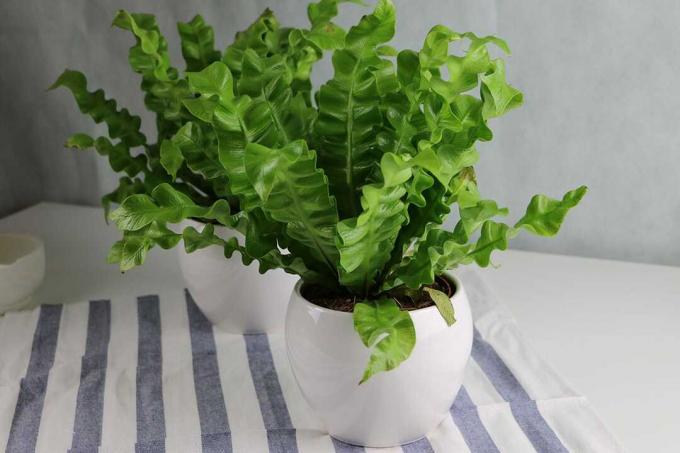
If you still have the feeling that the ferns are lacking nutrients, you can fertilize as follows:
- Use phosphorus fertilizer
- Period: spring to late autumn
- every 2 weeks
frequently asked Questions
Yes all Ferns are weakly to strongly poisonous. Compared to most species, house ferns are to be found in the area of the slightly poisonous plants and are therefore less dangerous in direct contact. You should still avoid eating the fronds or inhaling the spores directly, as this can lead to stomach upsets, nausea and headaches. This also applies to your pets.
Yes, the ferns are mainly evergreen plants. Indoor ferns inspire all year round with their different shades of green. In some species, the leaves die off at regular intervals, which is characterized by a brown hue. Possible damage caused by drought can be recognized by the brown leaves with light tips.
No, indoor ferns are plants that are sensitive to lime. For this reason, you should only use stale, filtered, or boiled water for watering and spraying the ferns. This has a positive effect on the vitality of the plants.
Pests and diseases are not a problem for the ferns. If the location is permanently too dry and the indoor fern is not sprayed, spider mites, scale insects and aphids can occur. Make sure the humidity is higher, water sufficiently and remove the infected fronds to contain the infestation.



